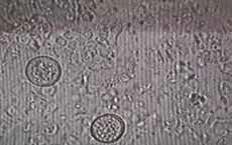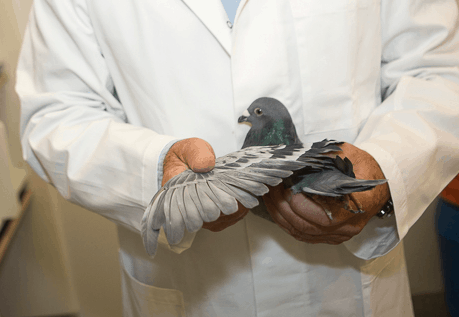

Looking back at the season
Coccidosis problems
Looking back at the season, we can conclude that there wasn’t much news from a medical point of view. On the understanding that due to the high rainfall and therefore high humidity in certain months, full-blown coccidiosis problems arose. Something we hadn’t actually seen in years.
Many thought that coccidiosis wasn’t a problem any more and so it seemed. In recent years we have only seen a few serious coccidiosis problems, but then came the wet season in 2016. We were regularly discovering heavy coccidiosis infections. Sometimes the pigeons were not thin and the droppings were still quite good. But the pigeons weren’t really getting into shape, their feathers and muscles were a bit dry. That can sometimes looks like ‘dry snot’, the big problem of pigeon racing over the past 45 years. I have referred to this on so many occasions, both verbally and in writing. Through good clinical research and a simple dropping test, coccidiosis appears to be the culprit. Whereas we consider 1 to 2 oocysts (a kind of egg of the protozoa coccidiosis) per field of view of the microscope as acceptable, we sometimes found 20 to 30 oocysts, so there were 10 to 20 times as many.
Treatment coccidiosis
Fortunately, coccidiosis can be treated very well with one simple tablet! And it also has condition boosting effects, as we have seen in recent years. Even if administered shortly before basketing, the pigeons get a ‘boost’ as it were, and quickly get into top condition with, as a result, a 1st place nationally as we saw in the last long-distance season.
This is not an unknown phenomenon; the pigeons suffer for example from a mild ornithosis, which you treat, and by clearing all kinds of bacteria they feel better, the condition is boosted and the pigeons perform abnormally well. We know this for example by administering the right ornithosis treatments shortly before basketing when the pigeons were not completely ‘tightly’ packed. Even rattling pigeons with wet eyes appeared after certain injections to get back into excellent condition in a short time. Apparently, a number of bacteria from the anterior airways (e.g. nose, eyes, sinuses) hinder the pigeons in such a way that they cannot get into shape and orientate less well and are less motivated.
The same law applies to coccidiosis, but also to trichomoniasis (canker). Clean up the pathogens and the pigeons get into shape quickly, become softer and tighter, the droppings look great and they start shedding down again! In case of coccidiosis you should disinfect the loft (e.g. with a burner) to kill the oocysts in the droppings and thus break the cycle!

Large losses
In 2016, unfortunately too many pigeons were lost, both young and old, including a number of ‘proven winners’. That really hurts. Fortunately, some of them are coming back. Much has been said and written about the losses of youngsters. This is far from always due to alleged diseases, that is obvious. We can learn something from those pigeon fanciers who lose very few pigeons. Try to find some kind of common denominator responsible for the less than usual losses! We should also not forget that there are fewer and fewer fanciers, and therefore fewer lofts, so the ‘straying’ pigeons don’t find a loft very quickly.
Registered veterinary medicines
At the many pigeon events and forums worldwide in which I participate, the question is regularly asked whether there are any new medicines in the pipeline. The answer is short and clear: “no”. The development of new medicines for pigeon racing is practically unaffordable. We are talking about hundreds of thousands of euros, it will take years and it will only be registered in a few countries at most. Many of the ‘pigeon medicines’ in the Netherlands, Belgium, Germany, England and Poland are illegal. They are not registered (anywhere)! European authorities are becoming increasingly alert and exchange more and more information on these illicit substances. Websites with illegal substances are visited by the government and here and there action is taken against them! Self-made pharmaceutical compounds prepared by vets themselves is also no longer allowed in Europe if you read the legislation on it.
Doping
Doping is making some waves at the end of the season, especially in Belgium. Several ‘greats’ have been mentioned, which is not good for the sport. The name morphine has been mentioned.
For the KBDB this is an annoying matter, but they have, very wisely, created a scientific committee (WAC) that deliberates and then informs the KBDB! Sometimes the problem is no longer about ‘whether you find’ a product on the doping list, but ‘how much you find’. In other words: minimum values (levels) should be scientifically examined or: which values could be explained by ‘contamination’ by foodstuffs and which values are too high and are no longer applicable. A difficult matter.
PCR-Method
In addition, when determining certain pathogens (bacteria) in our pigeons via for example the PCR method (Polymerase Chain Reaction, i.e. the identification of bacteria and viruses at the DNA level, via DNA technology), the results are no longer black and white. In short, this means that in the case of Salmonella (paratyphus), for example, the detection of a ‘low number’ of Salmonella bacteria is no longer conclusive for the diagnosis of paratyphus. So here too, we must learn to deal with the existence of minimum levels and interpret them carefully. Interestingly, everyday practice has always confirmed this; I have been saying it for many years: “it’s not about what you can find out about potential pathogens, but how many of them are there (threat of infection).
And then there is the individual resistance of the pigeon. If this, popularly put, is in balance with the number of pathogens, there is little going on.
BELGICA DE WEERD B.V. I Postbus 4607 I 4803 EP Breda I Nederland
T +31 76 560 02 22 I F +31 76 565 35 70 I info@belgicadeweerd.com I www.belgicadeweerd.com

